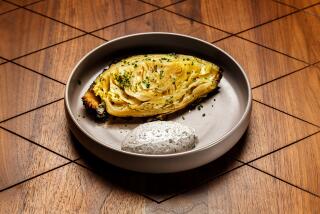Lean Times : Can the Healthy Attributes of White Meat Become Associated With Red?
- Share via
The recent re-categorizing of beef grades and naming pork “the other white meat,” are two indicators of a wide-scale offensive being launched by the meat industry, as it struggles to adjust to the demands of the ever-changing consumer. It is hoped that by focusing on the “new” leaner meat being presented at the marketplace, the healthy attributes of white meat can again be associated with red.
Press conferences and media spots during the past several months, have presented facts and figures to support the idea that meat is leaner, significantly trimmer, in fact, than it was five years ago. Beef and pork producers alike are not only leaving a fraction of the original external fat on their products but are also looking into production methods that will yield lower-fat products overall, all of this in order to restore meat’s position as a healthy protein, zinc and iron source.
Dr. Gary C. Smith, head of the department of animal sciences at Texas A&M; University, spoke at a press conference last week on the producers’ response to changes in consumer demands for beef.
He conceded that some important changes in the fat content of beef and in the out-dated, inconvenient preparation methods currently employed would have to be improved if positive consumer attitudes about beef are to be established. He explained that consumer surveys have shown (and consumption data has proven) that “the fat has to go” if people are going to feel OK about buying and consuming beef.
He indicated that a “niche market” somewhere between the classical cuts--steaks, roasts, stewing beef and ground beef--needs to be developed that can offer consumers a health benefit while offering the ease of preparation and versatility they desire.
After early attempts by the entire beef industry to ‘play ostrich’ on the diet/health/nutrition issues,” he said, there is now “considerable interest” in developing a product to fit the needs of health-oriented consumers. He added that in general, people “like the taste of fat and if possible, they would like to continue to eat it.” But, he said, most have an aversion to “plate waste” and therefore, see piles of fat collecting on their plates as economically foolish.
Instead, beef packers, by making genetic and feeding changes which make their animals leaner, and by removing most of the fat from beef in the box long before it reaches the retailer, are presenting cuts in the supermarket case that display no more than one-quarter-inch external fat and have a lower percentage of marbling (the veins of fat weaving through a cut of beef).
“Because so many people discard the fat either before cooking or once it’s on the plate, there’s no reason to put it in,” Smith said, so most packers will be looking into ways of sending their product to market in a leaner form. “If there is a relationship between beef consumption and heart disease, cancer, obesity and weight control, it is one of fat. Not all the data is in, but the take-home message is, if you eliminate the white (the fat), you can eat the red.”
Meanwhile, over at the National Pork Producers Council, the results of a survey, designed to measure the success of the pork industry’s campaign to position pork as “the other white meat” in the eyes of the consumer, conducted by Rozmarin & Associates, Omaha, have shown that consumers have not only begun to think of fresh pork as white meat, but they are also associating the perceived positive attributes of white meat with pork.
This new study sampled 1,800 decision-makers between the ages of 25 and 54 in six cities where participants had received varying levels of media exposure during the last seven months. The results were compared against data collected in January and February of last year, before the advertising campaign began.
According to the council’s figures, which were released in December, 1987, 49% of those surveyed thought pork was higher in calories than other meats compared to 60% who held that belief seven months prior to the survey. Fifty-one percent gave fresh pork a positive rating for versatility, compared to 43% in the previous study.
The bottom line, whether beef or pork is desired, is that the meat industry is responding to consumer and health groups’ concerns about its products by implementing production methods (including feeding practices and trimming techniques) that make leaner cuts available.
How these industry changes are perceived and implemented by consumers are key factors in the role of meat in heart-healthy diets of the future. Sensible menu planning also is an essential component. At this stage of the game, meat salads, stir-frys and finger foods all using the recommended 3 1/2-ounce serving are considered ideal uses of either beef or pork: they provide the versatility required if dieting is to be successful.
JAPANESE STEAK SALAD
Sesame Marinade and Dressing
1 pound well trimmed beef top sirloin steak, cut 1-inch thick
3 cups sliced napa cabbage, cut 1/4-inch
3 cups sliced romaine lettuce, cut 1/4-inch
1/2 cup thin diagonally sliced carrots
1/2 cup thin diagonally sliced radishes
1/2 cup thin diagonally sliced cucumber
1 cup cooked rice
24 Chinese pea pods, blanched
4 edible flowers, optional
Prepare Sesame Marinade and Dressing, following separate instructions for marinade and for dressing. Place marinade in plastic bag with steak, turning to coat. Close bag securely and marinate in refrigerator 2 hours, turning once.
Remove steak from marinade and place on rack in broiler pan so surface of meat is 3 to 4 inches from heat. Broil 14 to 16 minutes for medium-rare, turning once. Let stand 5 minutes. Carve steak into thin slices.
Meanwhile, combine cabbage, lettuce, carrots and radishes. Place on 4 individual plates. Arrange equal number of cucumber slices in circle at top of each plate. Mound 1/4 cup rice on top of each cucumber circle. Fan pea pods around both sides of rice. Arrange steak slices in spoke fashion on salad greens, radiating down from rice. Serve with reserved dressing. Garnish with edible flower. Makes 4 servings.
Sesame Marinade and Dressing
3 tablespoons dry Sherry
3 tablespoons light soy sauce
3 tablespoons rice wine vinegar
2 tablespoons hoisin sauce
1/2 teaspoon grated ginger root
1/4 cup water
2 tablespoons chopped green onion
1 tablespoon sugar
1 tablespoon toasted sesame oil
Combine Sherry, soy sauce, vinegar, hoisin sauce and ginger. Mix well. Divide mixture in half and reserve half for steak marinade.
To prepare dressing, combine remaining mixture with water, green onion, sugar and oil and mix well.
BEEF STEAKS OVER CARMELIZED
ONIONS WITH GARLIC POTATOES
2 beef top blade steaks, cut 3/4-inch thick, about 4 ounces each
1/2 teaspoon crushed rosemary
1/8 teaspoon coarsely ground pepper
1 medium onion, thinly sliced
2 teaspoons olive oil
1/2 teaspoon sugar
1/4 teaspoon salt
Garlic Potatoes
Trim excess fat from beef. Rub steaks with rosemary and pepper and set aside. Cook onion in oil in heavy non-stick skillet over medium heat 10 minutes, stirring occasionally. Sprinkle sugar over onion and cook and stir 1 minute. Remove from pan to warm plates and keep warm.
Heat skillet over medium heat 2 to 3 minutes. Pan broil steak 6 to 8 minutes, turning once. Season with salt. Serve steaks on onions with Garlic Potatoes arranged on side. Makes 2 servings.
Garlic Potatoes
5 ounces small new potatoes, unpeeled, quartered lengthwise
2 cloves garlic, halved
1/2 teaspoon salt
Water
1 tablespoon butter, softened
2 teaspoons finely chopped green onion or chives
Place potatoes, garlic and salt in small saucepan. Add water to cover and bring to boil. Cover pan loosely and cook 8 to 10 minutes or until tender. Drain, reserving potatoes and garlic. Remove garlic and crush with flat side of knife. Combine garlic with butter and green onion. Add to potatoes, tossing lightly to coat.
PORK AND RED CHILE STIR-FRY
2 tablespoons oil
1 pound lean boneless pork loin, cut into thin slices
4 cloves garlic, chopped
3/4 pound fresh green beans, cut into 2-inch lengths
2 teaspoons sugar
2 teaspoons soy sauce
2 small red chile peppers, thinly sliced
1 teaspoon shredded ginger root
1 teaspoon sesame oil
1 teaspoon rice wine vinegar
Heat oil in heavy skillet. Add pork and garlic and cook and stir until lightly browned. Add green beans and stir-fry until beans and pork are done, about 5 minutes. Push meat and beans to one side of skillet. Add sugar, soy sauce, chile peppers and ginger and stir to dissolve sugar. Add sesame oil and vinegar. Stir to coat meat and beans. Serve immediately. Makes 4 servings.
PORK MEDALLIONS WITH DIJON DILL SAUCE
1 pound pork tenderloin
1 teaspoon garlic salt
1/4 teaspoon black pepper
1/2 cup plain low-fat yogurt
4 teaspoons Dijon mustard
1/2 teaspoon dill weed
1/2 teaspoon sugar
Cut pork crosswise into 8 pieces. To make medallions, place each piece of pork, cut side down, on flat surface. Cover with wax paper and flatten gently with heel of hand to 1/4-inch thickness.
Pan-broil pork in non-stick skillet over medium heat 3 to 4 minutes per side. Remove medallions to warm platter and season with garlic salt and pepper on both sides.
Meanwhile, combine yogurt, mustard, dill and sugar. Serve sauce with pork medallions. To serve sauce warm, place mixture in heat-proof measure and warm in hot, not boiling, water 2 to 3 minutes. Do not cook or let curdle. Makes 4 servings.
PORK KEBABS WITH ORZO SALAD
1/2 cup soy sauce
1/4 cup water
1 tablespoon lemon juice
2 garlic cloves, minced
1/2 teaspoon ground ginger
1 pound boneless pork loin, cut into 1-inch cubes
1 cup orzo
Oil
2 tablespoons white wine vinegar
1 teaspoon oregano
Salt, pepper
1 small tomato, diced
1/2 cup Chinese pea pods
2 green onions
2 tablespoons chopped parsley
1 zucchini, cut into chunks
1/2 pound mushroom caps
Combine soy sauce, water, lemon juice, garlic and ginger. Marinate pork in mixture 3 hours in refrigerator.
Meanwhile, cook orzo according to package directions. Drain and place in bowl. Toss with 1 teaspoon oil, then cool to room temperature. Combine 2 tablespoons oil, white wine vinegar, oregano and salt and pepper to taste. Toss in tomato, peas, green onions and parsley and vinaigrette. Set aside.
Dip zucchini and mushroom caps into marinade, then thread pork and vegetables onto skewers. Grill over hot coals 10 to 12 minutes, turning frequently. Serve with salad. Makes 4 servings.
More to Read
Eat your way across L.A.
Get our weekly Tasting Notes newsletter for reviews, news and more.
You may occasionally receive promotional content from the Los Angeles Times.










